
 |
| ::: |
www.uti.gr :: Folklore - Culture :: |
Local old Customs |

Archaeological finds provide evidence that Lesvians have been involved with the arts since the 14th century BC. Owing to the plentiful deposits of clay on the island Pottery, and to a lesser extend the working of copper, flourished Gradually 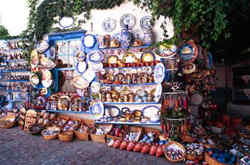 Lesvos became a well-known pottery centre and numerous workshops were established, especially at the areas of Agiassos and Mandamados.
Lesvos became a well-known pottery centre and numerous workshops were established, especially at the areas of Agiassos and Mandamados.
In the workshops various ceramic objects for daily or ornamental use were produced. The decorative motives had their origin in the Byzantine tradition and the beauty of the Lesvian nature.
The above small towns (Ayiasos and Mandamados) keep the tradition in pottery to this day and characteristic samples of the art are exhibited at the Folk Art Museums and Folk Collections of the island.
Fretwork also flourished, owing to the abundance of wood mainly from olive and chestnut trees. Fretwork was used in monasteries and churches for the creation of icon screens, iconostases and other objects and in houses (in “sachnisinia” (wooden balconies), roofs, doors, stairs) and of course in furniture.
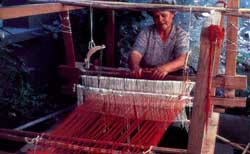 Even today the wooden chest or “Kassela” decorates the Lesvian house. In this case too, the decorative motives commonly used echo the Byzantine tradition and nature. Today, the visitor can admire older fretwork items at Folk Art Museums and Folk Collections as well as visit wood carving workshops.
Even today the wooden chest or “Kassela” decorates the Lesvian house. In this case too, the decorative motives commonly used echo the Byzantine tradition and nature. Today, the visitor can admire older fretwork items at Folk Art Museums and Folk Collections as well as visit wood carving workshops.
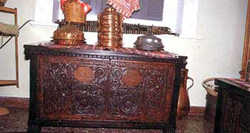
The island was also famous for its weaving: yarns dyed with plant dyes were used to weave colourful textiles in wooden looms. Weaving was an occupation reserved to women. In this case too, it is nature that provides most of the motifs used.
The visitor can admire samples of this craft at the Folk Art Collections of the island and also buy unique traditional textiles from various workshops and Women's Co-operatives at the villages and small towns of Lesvos.
www.uti.gr :: Folklore - Culture :: |
Local old Customs |
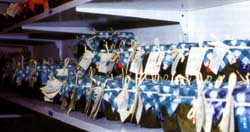
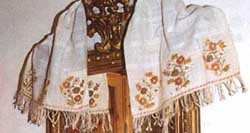 In Lesvos, the customs and the traditions are undoubtedly connected with religion. In all religious celebrations, old customs revive: traditional dishes and sweets are prepared, carols and other songs fill the streets and other traditional festivities are organised. In fact all significant events in people's lives such as birth, wedding and baptism are linked to one or another custom.
In Lesvos, the customs and the traditions are undoubtedly connected with religion. In all religious celebrations, old customs revive: traditional dishes and sweets are prepared, carols and other songs fill the streets and other traditional festivities are organised. In fact all significant events in people's lives such as birth, wedding and baptism are linked to one or another custom.
In the recent years local cultural societies offer a lot to the effort to record and revive old customs since they are an indistinguishable part of the Lesvian identity.
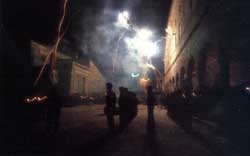
www.uti.gr :: Folklore - Culture :: |
Local music and dances |
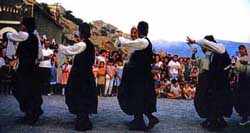 Lesvian music, songs and dance were influenced by the Greek inhabitants of the Asia Minor.
Lesvian music, songs and dance were influenced by the Greek inhabitants of the Asia Minor.
Folk music groups accompanied by dancers dressed in traditional costumes - even today - give a unique tint of joy and authenticity to all Lesvian celebrations: at festivities and local fetes, at weddings, and national holidays.
It's worth-noticing that even today the traditional musical instrument “santouri” (a type of dulcimer), present in every local musical composition, is still made in Lesvos.
Typical traditional dances are the “Lesvian”, the “Mytilenean” and the ”Ballos“ and they all display the spirited makeup of the Lesvian soul and its love for free expression
www.uti.gr :: Folklore - Culture :: |
The Local Costume |
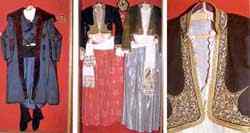 The visitor of Lesvos can see typical samples of the local costume at many Folk Art Collections on the island. A characteristic element of the Lesvian costume - both male and female - is the "vraka" (large breeches).
The visitor of Lesvos can see typical samples of the local costume at many Folk Art Collections on the island. A characteristic element of the Lesvian costume - both male and female - is the "vraka" (large breeches).
The male costume is completed by a white or black shirt, a black vest, black cap - "katsoula" - and black shoes.
The female one, in which the colourful "vraka" could be replaced by a long silk skirt, is completed by a shirt and vest, while on the head the colorful "tsemberi" (Kerchief) is worn. In festive days dresses embroidered in golden thread or hand woven silks were used.
Heavy fur coats ("patatoukes") and woolen jackets were typically worn in winter.
www.uti.gr :: Folklore - Culture :: |
Local festivities and fetes |
Quite often, especially in the summer months, the island comes to life with a fair which, in addition to the standard singing and dancing which often goes on for three 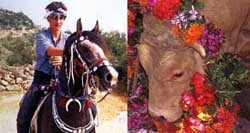 days and nights, also includes horse and other races as well as processions or cultural events.
days and nights, also includes horse and other races as well as processions or cultural events.
Among the festivities that attract the largest number of people are the fete of Taxiarchis at Mantamados on the Sunday of Myrrh Bearing and the fete of the Bull at Ag. Paraskevi on the 1st of June.
Characteristic of both are the slaughtering of a bull, a remnant of pre-Christian animal sacrifices, and the horse races. Throughout the night, under the sound of songs keskeki (a meat stew with wheat and plenty of cumin) is cooked in large cauldrons over open-air fires and on the following morning it is given out to the pilgrims.
A unique day for the island is the 15th of August, the day of the Assumption, 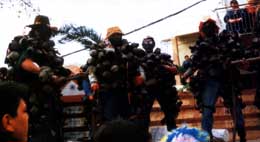 which is especially celebrated at Petra and Agiassos. People of all ages from the whole island head uphill, often on foot, to the village, and many of them spend the night out in the open in the church's courtyard or in the surrounding areas.
which is especially celebrated at Petra and Agiassos. People of all ages from the whole island head uphill, often on foot, to the village, and many of them spend the night out in the open in the church's courtyard or in the surrounding areas.
Junketing is also at its best during carnival, especially at Mesotopos, with the koudounatoi, (men loaded with cowbells) and at Agiassos where satirical teasing still continues an ancient custom. In the summer there are festivities in several parts of the island.
The Feast of the Sardine at Kalloni, of Ouzo at Mytilini and Plomari, of Trata at Petra and Skala Polychnito. Concerts, plays, art and photo exhibitions, lectures, horse races and fairs, local singing and dancing will give the visitor a look into the island's junketing.
| © 2002-2003 www.uti.gr |